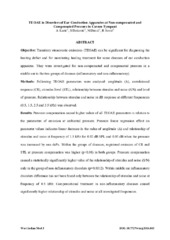Приказ основних података о документу
TEOAE in Disorders of Ear Conduction Apparatus at Non-compensated and Compensated pressure in Cavum tympani
| dc.creator | Karić, Aleksandar | |
| dc.creator | Đoković, Sanja | |
| dc.creator | Dimić, Nadežda | |
| dc.creator | Savić, Radomir | |
| dc.date.accessioned | 2021-06-17T13:27:59Z | |
| dc.date.available | 2021-06-17T13:27:59Z | |
| dc.date.issued | 2016 | |
| dc.identifier.issn | 2309-5830 | |
| dc.identifier.uri | http://rfasper.fasper.bg.ac.rs/handle/123456789/2597 | |
| dc.description.abstract | Objective: Transitory otoacoustic emissions (TEOAE) can be significant for diagnosing the hearing defect and for monitoring healing treatment for some diseases of ear conduction apparatus. They were investigated for non-compensated and compensated pressure in a middle ear in the two groups of diseases (inflammatory and non-inflammatory). Methods: Following TEOAE parameters were analysed: amplitude (A), correlational response (CR), stimulus level (STL), relationship between stimulus and noise (S/N) and level of pressure. Relationship between stimulus and noise in dB response at different frequencies (0.5, 1.5, 2.5 and 3.5 kHz) was observed. Results: Pressure compensation caused higher values of all TEOAE parameters in relation to the parameters of emission at ambiental pressure. Pressure linear regression effect on parameter values indicates linear decrease in the value of amplitude (A) and relationship of stimulus and noise at frequency of 1.5 kHz for 0.02 dB SPL and 0.03 dB when the pressure was increased by one daPa. Within the groups of diseases, registered emission of CR and STL at pressure compensation was higher (p<0.01) in both groups. Pressure compensation caused a statistically significantly higher value of the relationship of stimulus and noise (S/N) only in the group of non-inflammatory disorders (p=0.0312). Within middle ear inflammatory disorders difference has not been found only between the relationship of stimulus and noise at frequency of 0.5 kHz. Compensational treatment in non-inflammatory diseases caused significantly higher relationship of stimulus and noise at all investigated frequencies. Conclusion: Pressure compensation in middle ear had a significant effect on obtaining TEOAE responses and their size. | |
| dc.rights | openAccess | |
| dc.rights.uri | https://creativecommons.org/licenses/by-nc-nd/4.0/ | |
| dc.source | West Indian Medical Journal | |
| dc.subject | Inflammatory and non-inflammatory disease | |
| dc.subject | middle ear | |
| dc.subject | otoacoustic emissions | |
| dc.subject | pressure compensation | |
| dc.title | TEOAE in Disorders of Ear Conduction Apparatus at Non-compensated and Compensated pressure in Cavum tympani | en |
| dc.type | article | |
| dc.rights.license | BY-NC-ND | |
| dc.citation.epage | 14 | |
| dc.citation.other | 65: 1-14 | |
| dc.citation.rank | M23 | |
| dc.citation.spage | 1 | |
| dc.citation.volume | 65 | |
| dc.identifier.fulltext | http://rfasper.fasper.bg.ac.rs/bitstream/id/10790/karic_et_al-teoae_at_non-compensated_and_compensated_pressure.pdf | |
| dc.identifier.rcub | https://hdl.handle.net/21.15107/rcub_rfasper_2597 | |
| dc.type.version | publishedVersion |


